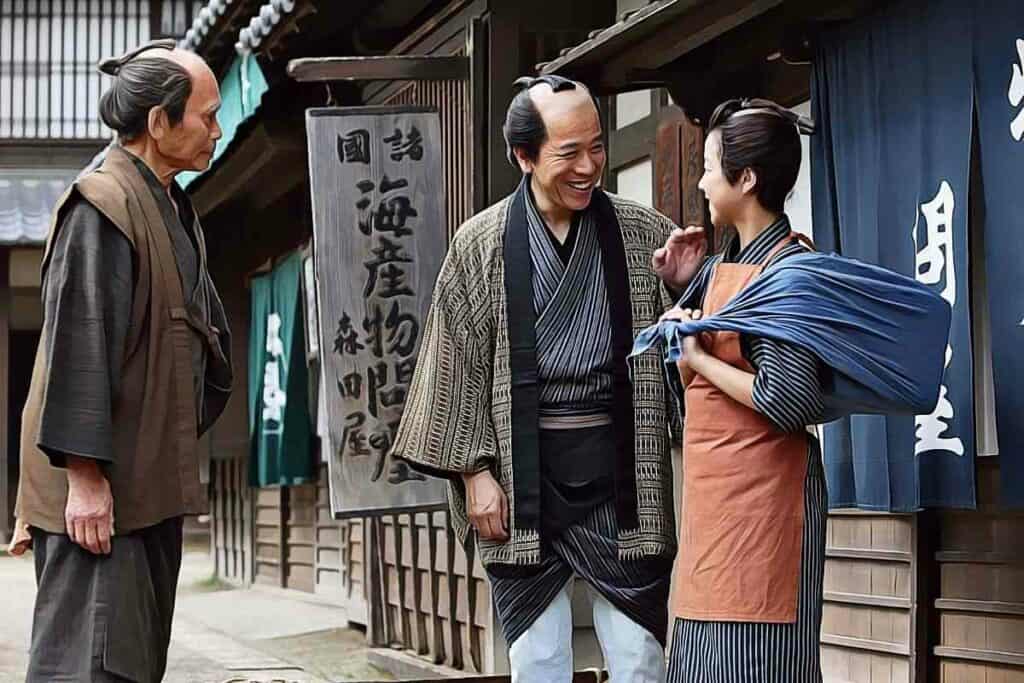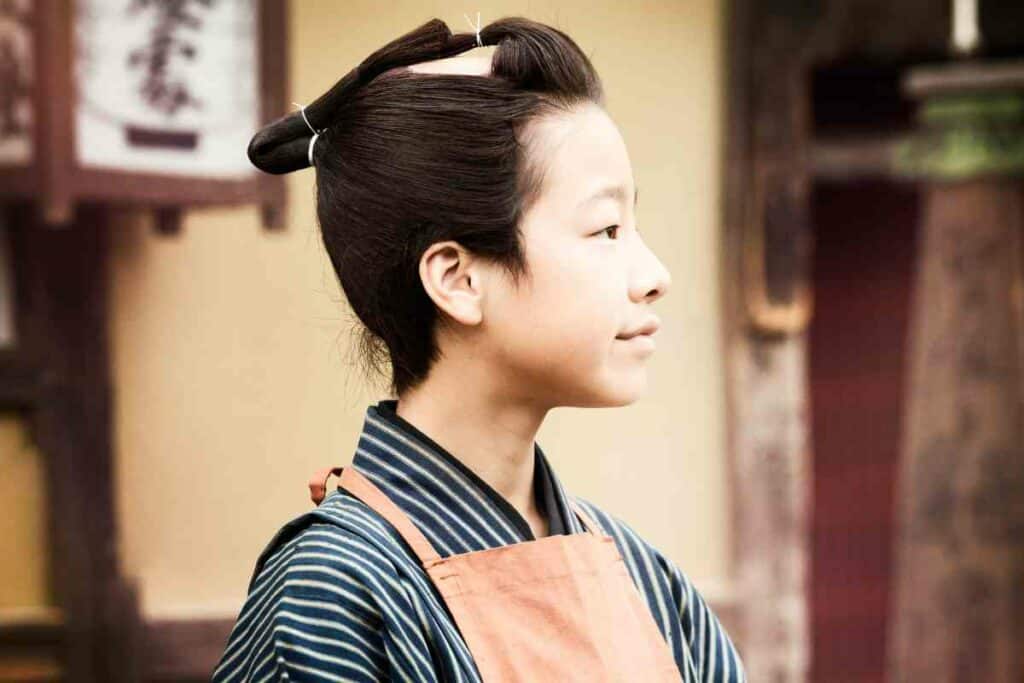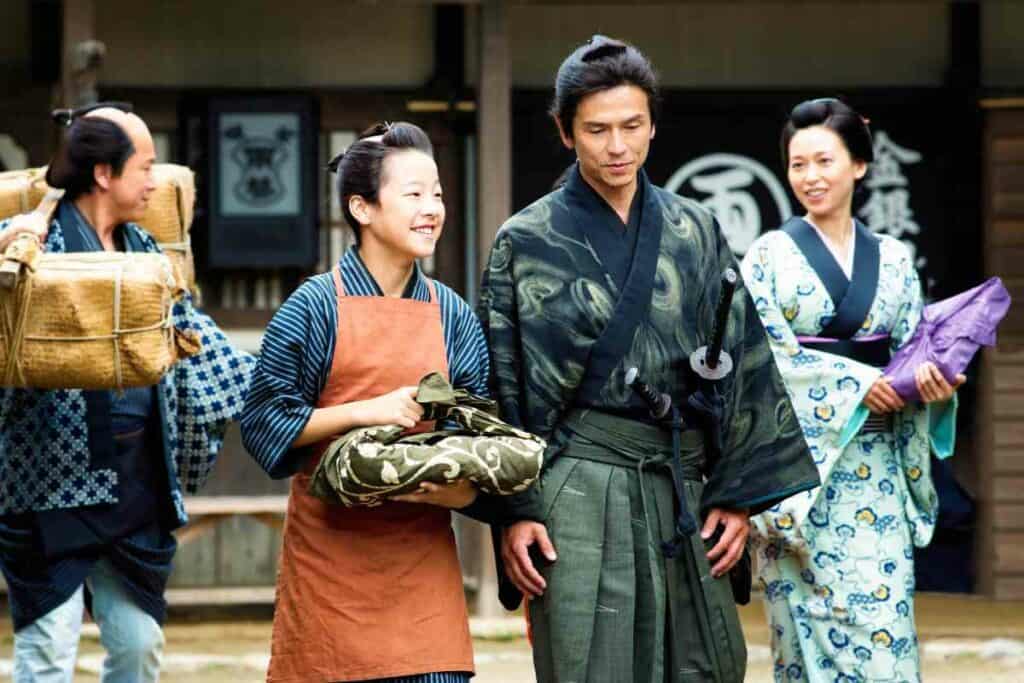Japan has produced some of the world’s most well-known foreign films and is home to Asia’s second-largest film industry.
So it’s no surprise that Japanese movies may be up and coming on your movie night list.

One of the great things about Japanese films is the massive range of films to choose from.
But if you’re new to Japanese film, where do you start? In this article, we skip the action, drama, animation, and horror to share 4 of the best Japanese films for learning more about Japanese film and cinematography.
Table of Contents
The Japanese film industry is one of the oldest in the world
Films are big business in Japan! The film industry is called Nihon eiga (日本映画) and has been in existence for well over a hundred years.
Filmmaking took off with the arrival of the first cameramen on the island in 1896 and the display of silent films on the vitascope and kinetoscope.

Interestingly, the moving image was not new to the Japanese who had developed pre-cinematic animation devices like the magic lantern.
The Japanese embraced film, building on the rich Kabuki theatre tradition and introducing storytellers to narrate the first silent films.
As film-making technology advanced, Japanese films became more sophisticated and began to outcompete imported foreign films, with many Japanese actors becoming stars in their own right.
Today, it has grown to become the world’s fourth-largest film industry with a multi-billion dollar revenue. The domestic market for Japanese films is stronger than ever with Japanese films grossing 54% of box office revenue.
The best Japanese films for anyone serious about cinema
[lasso type=”table” id=”37″ link_id=”6999″]
For our selection of the best Japanese films, we have looked at the rich selection of non-fiction film-making that has come out of Japan’s prolific film industry.
These underappreciated films are gradually being recovered and championed by a new generation of Japanese film fans.
If you want a film that entertains and informs you rather than the usual mainstream horror and animation, these important films should be part of your next movie night.
1. Hiroshima (ひろしま) (1953)
Hiroshima is an extremely important film that tells the story of the aftermath of the atomic bombing of Hiroshima.
| Title | Hiroshima |
| Release date | 1953 |
| Genre | War drama |
| Starring | Eiji Okada, Yumeji Tsukioka, Yoshi Katô |
| Director | Hideo Sekigawa |
| Running time | 104 min |
| Language | Japanese |
Unlike many of the films and documentaries made about this horrific period of modern history, Hiroshima, directed by Hideo Sekigawa, is made by the Japanese and based on eyewitness accounts of Japanese children who survived the bomb.
This moving docudrama is adapted from the book Children Of The A Bomb (Genbaku no ko), which was published in 1951.
The graphic accounts within the book are all written by children who survived the atomic bomb and were carefully compiled by Dr. Arata Osada. Some were only four or five years old at the time.
You may also like ?
This difficult subject matter and the strong anti-American sentiment of this film led to its release being severely limited.
Support for making the film came from the Japanese Teachers Union (JTU) which wanted the events reenacted to prevent the atrocity from ever happening again. However, the film has recently resurfaced and is receiving well-deserved acclaim.
A clip from Hiroshima (1953)
This difficult clip from the opening of the film shows the aftermath of the A-bomb explosion (not suitable for young children):
Where can I see Hiroshima (1953)?
You can rent or buy this film to stream online. There are several versions of this film due to heavy editing and censorship. The film is in Japanese with English subtitles.
Hiroshima (ひろしま) plot summary
The film opens with a radio broadcast about the bombing of the city being listened to by a teacher and students.
As a girl cries out her nose begins to bleed, indicative of leukemia that afflicted many of the children after the bomb.
The film follows a class of students, along with their teachers and families in the period following the bomb. Victims of the bombing led hard, afflicted lives, and many of the children were orphaned and reduced to poverty.
Difficult scenes include children begging and scavenging, gambling, and being discriminated against.
Extras who were actually from Hiroshima participated in a re-enactment of the scenes that immediately followed the explosion.
These scenes were combined with documentary footage that brought home the scale and impact of the destruction of so many lives.
Hiroshima does not shy from leveling the blame for the massacre at the door of the Imperial Japanese military bureaucracy and implicating America as an aggressor.
Japanese censors had tried to remove mentions of American occupation in the aftermath of the war, but Sekigawa makes it clear that the country was occupied by showing the presence of soldiers.
This directly challenged the narrative that the Japanese were self-determining after the war.
Why is Hiroshima one of the best Japanese films?
This film provided an opportunity for many people to see what happened to the people of Hiroshima.
Rather than leaving this fateful event as a historical footnote and abstract images of a mushroom cloud, Hideo Sekigawa, confronted the audience with the authentic horror of war, stripped of the propaganda and unrelenting in its tragedy.
It is easy to see why this film became heavily censored as it simply did not fit the narrative that was to be presented about the war.
Yet revisiting the horrors of Hiroshima is important for younger generations who may need to take a stand against the needless wastage of human life in contemporary conflicts.
Many of the actors in Hiroshima went on to have successful film careers. In particular, Yoshi Katô and Isuzu Yamada became famous actors from the 1950s through to the 1990s.
2. Jiro Dreams of Sushi (2011)
If you are looking for something lighter than manga animations or Japanese horror films, this feel-good Japanese-American documentary film will entertain and inform you.
David Gelb, an American filmmaker obtained a unique opportunity to follow one of Japan’s most revered sushi masters, 85-year-old Jiro Ono (小野 二郎).
| Title | Jiro Dreams of Sushi |
| Release date | 2011 |
| Genre | Documentary film |
| Starring | Jiro Ono |
| Director | David Gelb |
| Running time | 81 min |
| Language | Japanese |
In the film, Jiro Ono owns a small and unassuming, 10-seat sushi restaurant in a Tokyo subway station.
However, this restaurant is renowned for its single $270 omakase menu, where Ono serves customers a tasting menu of 20 courses. The restaurant, Sukiyabashi Jiro, holds three Michelin stars.
Ono is a sushi rockstar and has fed some of the most famous people in the world including the late Shinzo Abe and Barack Obama. As one of the greatest living sushi craftsmen, people travel from around the world to dine at his sushi bar.
Gelb’s film also introduces, Jiro’s two sons and apparent heirs, who are also sushi chefs. The film anticipates which of the two middle-aged men will succeed their father to run the sushi restaurant.
Read Next ?
Jiro Dreams of Sushi trailer
Jiro is an inspirational character who gets to share his craft with the world through this motivational film.
Did you know that he is almost 98 now and still working?!
Take a look at the trailer for Jiro Dreams of Sushi:
Where can I see Jiro Dreams of Sushi?
You can rent or buy Jiro Dreams of Sushi on DVD/Blu-ray or stream this documentary film online. It is available on Netflix and Amazon:
Take a Look ?
Jiro Dreams of Sushi plot summary
Jiro the sushi chef is still working daily, buying premium fresh fish at Tsukuji market to serve to customers at his premium sushi restaurant Sukiyabashi Jiro.
His eldest son and heir, Yoshikazu has the seemingly impossible task of maintaining his father’s legacy. David Gelb observes the rhythms, rituals, and pressure of keeping the family business going.
The film captures the personality and habits of a Japanese master craftsman, particularly the obsessiveness and attention to detail. It’s clear that Ono’s upbringing in post-war Japan shaped Ono.
Abandonment by his father and the subsequent struggle to survive were drivers for his ambition to succeed in establishing himself in sushi-making. And yes, Jiro confesses that he does indeed dream of sushi!
The contrast with Ono’s sons is stark as they have always had their father’s guiding hands and the comforts of a modern, stable first-world economy. So he can seem to be a little overbearing at times.
Yoshikazu the eldest son and heir is expected to take the reins of the business, but Ono shows zero signs of slowing down.
Once dreaming of racing cars, he dutifully rides his bicycle to Tsukuji Market to buy fresh fish for his father. Younger son Takashi has already left to run a branch of the restaurant in the Roppongi district.
This remarkable documentary also provides insight into the fish markets of Tokyo and the peculiarities of the different merchants.
With the raw materials for his trade carefully gathered, we are treated to the masterful preparation of Jiro Ono’s 20-course sushi feast, set impeccably to classical music.
The Japanese restaurant critic Masuhiro Yamamoto is also featured in the film and provides commentary on Ono’s legendary omakase, comparing it to a concerto.
Why is Jiro Dreams of Sushi one of the best Japanese films?
Jiro Dreams of Sushi seizes the opportunity to enter a sushi master’s world and experience the sacrifice and relentless perfectionism of this craft.
The film beautifully captures a way of life and shares many lessons and insights from Jiro’s many decades in sushi. You learn crazy stuff like how he massages octopus for hours to tenderize it so loses the expected rubberiness.
The flagellation of the apprentices is also something to behold. Apprentices are common in most cultures and trades, and Ono ensures that his apprentices are suitably exercised.
One apprentice had to make more than 200 egg treats just so Ono could identify the best one to serve. But this is what makes his 30-minute menu one of the most expensive in Tokyo.
You’ll learn to love Jiro and his dedication to his craft. His unrelenting hard work and dedication are inspiring.
There are definitely many lessons to take away from this beautifully composed film and it is one that you can easily watch many times, picking out different details and the sage-like wisdom of this sprightly old man.
3. Tokyo Olympiad (1965)
A line-up of the best Japanese films would be incomplete without mentioning the famous sports documentary Tokyo Olympiad.
This film, directed by Kon Ichikawa was commissioned by the 1964 Tokyo Olympics Committee.
However, with this masterpiece of cinematography, they got way more than they bargained for.
| Title | Jiro Dreams of Sushi |
| Release date | 1965 |
| Genre | Documentary film |
| Starring | Jiro Ono |
| Director | Kon Ichikawa |
| Running time | 81 min |
| Language | Japanese |
Ichikawa pioneered a range of cinematographic techniques that are now routine in filming sports including
- The use of telephoto lenses
- Low frame rate photography
- Slow motion sequences
Tokyo Olympiad is an impressive study of sportsmanship and the human form. Ichikawa went to great lengths to capture the physicality and expression of the human body in motion.
The film whittles down hundreds of hours of footage of the athletes in competition across 20 sports.
Where can I see Tokyo Olympiad?
The great news is that Tokyo Olympiad has been restored and re-released online. It is available on Amazon for streaming or Blu-DVD purchase.
Tokyo Olympiad documentary
If you want to learn more about the Tokyo Olympiad production, this short documentary that accompanies the re-release of the film includes footage of Tatsumi Ichikawa, the director’s son and longtime collaborator Chizuko Osada talking about aspects of the film:
Tokyo Olympiad summary
The Japanese government wanted the 1964 Summer Olympics to welcome the world in peace and showcase their repaired nation after the destruction of WWII.
The stakes were extremely high for re-introducing Japan, and its modern, advanced economy on a positive note.
Filming at the Games was a high priority as every Summer Olympics has been recorded on film. The Japanese government was keen to produce the film themselves.
Their first choice was the famous Japanese director Akira Kurosawa, but he wanted complete control over the production of the entire Olympic opening and closing ceremonies.
Instead, Ichikawa stepped in to complete the project while allowing officials the level of control they wanted.
Ichikawa’s production also ran into problems with the authorities, who wanted an objective historical record of the Tokyo Olympics.
Ichikawa created an artistic production that focused primarily on the sportspeople and spectators, rather than the infrastructure and areas the government wanted to highlight.
In the end, a significant amount of footage, at least 50 minutes, had to be cut from the film to get a more journalistic result.
Why is Tokyo Olympiad one of the best Japanese films?
Despite being ruthlessly edited, Tokyo Olympiad has been recovered as a masterpiece of Japanese cinema. Many people consider the film to be the greatest ever film about sports.
With over a thousand cameras and hundreds of production assistants, Tokyo Olympiad communicates the spectacle and performance of an Olympic Games with previously unseen detail and intimacy.
The beautiful widescreen images recorded using the latest telephoto lenses always meant that the film would be ahead of its time and capture the triumphs and failures of the athletes and hold the viewer’s attention.
The film has some amazing footage of the Ethiopian marathoner Abebe Bikila, whose marathon race provides a narrative focus.
4. Tokyo Story (1953)
Tokyo Story (1953) is the most famous of the Japanese films shared here. It regularly features in critics’ and directors’ lists of the greatest films of all time, even beating Citizen Kane.
| Title | Jiro Dreams of Sushi |
| Release date | 1965 |
| Genre | Documentary film |
| Starring | Jiro Ono |
| Director | Kon Ichikawa |
| Running time | 81 min |
| Language | Japanese |
Directed by Yasujirō Ozu (小津 安二郎), this pleasant film about aging parents visiting their children in the city, became recognized and acclaimed by critics around the world in subsequent decades.
Tokyo Story trailer
Here is the original trailer for Tokyo Story. Delicate, nuanced, and expanding beautifully like a paper flower in water. Smiling moms are the same the whole world round!
Where can I see Tokyo Story?
The great news is that Tokyo Story has been restored and re-released online. It is available on Amazon for streaming or Blu-DVD purchase.
Tokyo Story summary
This outstanding family drama centers on aging parents Shūkichi and Tomi Hirayama who leave their home in Western Japan to visit their adult children in the bustling city of Tokyo.
Their professional children, including a teacher and a doctor, are extremely busy and have little time to entertain the parents, but the widow of their deceased son, Noriko, makes space for them in her life.
The film explores family dynamics and the challenges of keeping a family together as siblings grow and lead different lives.
There are some sad moments, especially towards the end of the film, but there is much to reflect on and director Ozu expertly captures family dynamics that people anywhere around the world can relate to.
Why is Tokyo Story one of the best Japanese films?
The beauty of this film is its innocence and simplicity.
There are no salacious plot twists or drama and the slow pace of Ozu’s film put many Japanese and overseas audiences off. This film was originally considered pedestrian and ‘too Japanese’ to be worthy of international distribution.
However, by the late 1950s, increasing international attention on Japanese film revived interest in Ozu’s work, with it winning the Sutherland Trophy for most original and creative film in 1958.
The carefully crafted and captured relationships resonated with audiences and Ozu’s understated but highly nuanced approach earned the rave reviews it always deserved.
Best Japanese films FAQs

What are Japan’s most famous film locations?
– The 2008 film Departures was filmed in Yamagata Prefecture
– The 2012 Bond film Skyfall was filmed scened in an abandoned building on Hashima Island, Nagasaki
– Oscar-winning movie Memoirs of a Geisha was filmed by the vivid orange gates of Fushimi Inari, Kyoto
– Engyoji Temple, Himeji was a key location in the 2003 Tom Cruise blockbuster The Last Samurai
Have Japanese films ever won an Oscar?
They include:
– 2022 Drive My Car (Best International Feature Film)
– 2002 Spirited Away (Best Animation)
– 1987 The Last Emperor (Best Original Score)
– 1957 Sayonara (Best Supporting Actress)
What are the biggest film studios in Japan?
– Toho
– Toei
– Shochiku
– Kadokawa
Does Japan have its version of the Oscars?
Read Next ?
In Conclusion
Japan has a great reputation for producing amazing films.
Though it’s easy to reach for the latest blockbusters, independent Japanese films, as well as those from eras gone by provide valuable insight into what is unique about Japanese culture.
We hope that this selection of the best Japanese films prompts you to expand your film collection with these thoughtful and challenging films.
- 12 Things Tourists Should NEVER Say in Japan
- Kissing Robot: Exploring the Popularity of the Chinese Kissing App
- Unlocking the Secret Dating Rituals Only Locals Know in Japan
- Samurai Armor: Ancient Protection for Japan’s Elite Warriors
- 10 Amazing Facts About Schools in Japan: Unique Traditions and Educational Practices
- Where can you see snow monkeys in Japan: Best locations and viewing tips












